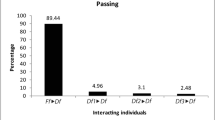Abstract
A pair of the house musk shrews (Suncus murinus) was placed in an observation box and their interactive behavior was analyzed. The animals often engaged in alarm vocalization, tail biting, and body biting and wrestling, respectively, for the inter-male, inter-female and male-female pairs. Thus, for this species, the interactions were found to be basically aggressive. An analysis of the behavioral sequences suggested that the males have more diverse behavioral responses to other males than do the females. Males smaller in weight approached and escaped more frequently than the larger ones, whereas the weight had no effect on the female pairs. Inter-male interactions consisted mainly of approach (facing) and escape, inter-female interactions included alarm vocalization in addition to the inter-male behavioral patterns, and the main form of male-female interaction was the male's chasing the female.
Similar content being viewed by others
References
Archer, J. 1988 The Behavioural Biology of Aggression. Cambridge University Press, New York.
Baxter, R.M. & Meester, J. 1982 The captive behaviour of the red musk shrews,Crocidura f. flavescens (I. Geoffroy, 1827) (Soricidae: Crocidurinae).Mammalia, 46, 11–27.
Dryden, G.L. 1975 Establishment and maintenance of shrew colonies.International Zoo Yearbook, 15, 12–18.
Furumura, K., Kuriki, T., Ota, K. & Yokoyama, A. 1985 Reproduction. In: K. Kondo (ed.)Suncus Murinus: Biology of the Laboratory Shrew, pp. 126–139. Japan Scientific Societies Press, Tokyo (In Japanese with English abstract).
Goulden, E.A. & Meester, J. 1978 Notes on the behavior ofCrocidura andMyosorex (Mammalia:Soricidae) in captivity.Mammalia, 42, 197–207.
Grant, E.C. 1963 An analysis of the social behaviour of the male laboratory rat.Behaviour, 21, 260–281.
Huston, J.P. & Bureŝ, J. 1983 Innate and motivated behavior. In: J. Bureŝ et al. (eds.),Techniques and Basic Experiment for the study of Brain and Behavior, pp. 77–133. Elsevier Science Publishers B. V., New York.
Kondo, K. & Oda, S. 1977 Domestication of a wild species of Insectivora for the laboratory animal.Exp. Anim., 26, 273–280 (In Japanese).
Lehman, M.N. & Adams, D.B. 1977 A statistical and motivational analysis of the social behaviors of the male laboratory rat.Behaviour, 61, 238–275.
Lewis, D.B. & Gower, D.M. 1980 Biology of Communication. Blackie and Son Led, Glasgow/London.
Lorenz, K. 1966 On aggression, Methuen London.
Marques, D.M. & Valenstein, E.S. 1977 Individual differences in aggressiveness of female hamsters: Response to intact and castrated males and to females.Anim. Behav., 25, 131–139.
Moyer, K.E. 1976. The Psychobiology of Aggression. Harper & Row, New York.
Rissman, M.F. 1987 Social variables influence female sexual behavior in the musk shrew (Suncus murinus).J. Comp. Psychol., 101, 3–6.
Robitaille, J.A. & Bovet, J. 1976 Field observations on the social behaviour of the Norway rat,Rattus norvegicus (berkendhout).Biol. Behav., 1, 289–308.
Tsuji, K. 1981 Some problems on the study of animal behavior in laboratory: Experiments with the house musk shrew (Suncus murinus).J. Facul. Letters, Nagoya Univ., 81, 37–52 (In Japanese).
Tsuji, K. 1989 Modification of early behaviour and reproductive behaviour in the process of domestication.The Report for the Grant-in-Aid for Scientific Research, (In Japanese).
Tsuji, K. 1990 Sexual behaviors and male's postejaculatory attack to female in the domesticated house musk shrew (Suncus murinus). Abstracts for 12 Ethologentreffen, 101.
Tsuji, K. & Naruse, I. 1985 Behavior characteristics in the domesticated house musk shrew, Suncus murinus. In: K. Kondo (ed.)Suncus Murinus: Biology of the Laboratory Shrew, pp. 459–475. Japan Scientific Societics Press, Tokyo. (In Japanese with English abstract).
Ulrich, R.E., Hutchinson, R.R. & Azrin, N.H. 1965 Pain-elicited aggressionPsyhol. Rec., 15, 111–126.
Author information
Authors and Affiliations
About this article
Cite this article
Kawano, K. Aggressive behavior of the domesticated house musk shrew (Suncus murinus) in inter-male, inter-female and heterosexed interactions. J. Ethol. 10, 119–131 (1992). https://doi.org/10.1007/BF02350116
Received:
Accepted:
Issue Date:
DOI: https://doi.org/10.1007/BF02350116



